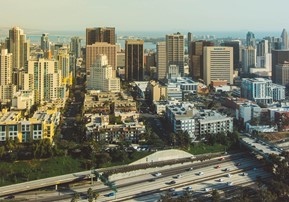Archived Content
This site contains information that has been considered archived and will no longer be updated.
EDA’s Economic Integrator Catalyzes Interagency Investments in San Diego
Nestled between Balboa Park and the San Diego International Airport, Maple Canyon is a unique green space that buffers business with nature inside San Diego’s sprawling, urban core. When flooding hit the canyon in 2017, a vast ecosystem of interdependent commercial enterprises, transportation networks, and natural habitats was impacted.

Frances Sakaguchi, a Regional Economic Development Integrator (EDI) with the Seattle Regional Office (SRO), was contacted about a project that could impact economic development more than a mile from the source. To help the community capitalize on the opportunity, EDI Sakaguchi and EDA Economic Development Representative (EDR) for Southern California, Wil Marshall, convened multiple meetings with organizations and agencies, including the Federal Emergency Management Agency (FEMA), the San Diego Port Authority, the City of San Diego Public Works, City Transportation and City Parks Department, the California State Coastal Conservancy, impacted port businesses, and local non-profit and neighborhood groups. Instead of a Washington-knows best approach, EDA modeled its approach on REDS (Regional Economic Diversification Summit) by responding directly to local and regional economic development issues through the identification of resources and the building of coalitions.
This process identified several significant roadblocks to future economic development in and around Maple Canyon, in areas that were exposed, affected and exacerbated by the 2017 flooding. Storms caused severe run-off, erosion, and damage to drainage systems, while also restricting local access to businesses and the airport, putting thousands of jobs at risk. Additionally, excess water and debris flowing into San Diego Bay had a detrimental effect on aquaculture and marine life.
Coming out of the EDA-led convening process, federal, state and local resources were catalyzed to work together towards improving their stormwater infrastructure to mitigate the impact of flooding on local industry.
A $6 million EDA grant to the city of San Diego was matched with $6 million in local investment to support the final design, permitting, easement acquisition, and construction of vital infrastructure needed to protect San Diego businesses. The project includes innovative upstream improvements to reduce runoff and debris deposited into the city’s stormwater infrastructure.
By enhancing green infrastructure, the EDA and local investment will improve the operation of traditional infrastructure, while enhancing passive outdoor recreation and economic development opportunities for the region.
Thanks to the cooperation of federal, state, and local agencies — working with private sector partners — nearly 2,000 jobs dependent on the commercial-environmental ecosystem centered on Maple Canyon have been retained and an important landscape in urban Southern California preserved.
